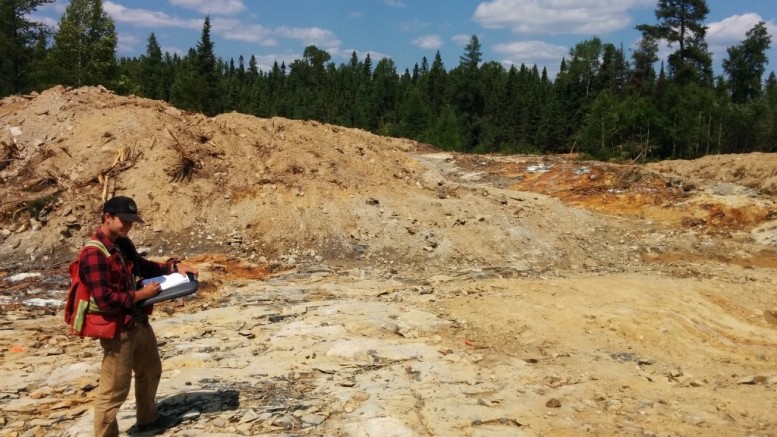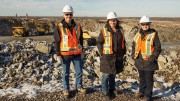Wallbridge Mining (TSX: WM) and its largest shareholder, Lonmin (LSE: LMI), have approved a $3.95-million drill program starting Oct. 1 for their Parkin nickel-copper-platinum group metal (PGM) project near Sudbury, Ontario.
The 18,000- to 20,000-metre drill program will build on earlier exploration programs that have expanded near-surface mineralization at the property. The funds will also be used for ground and borehole geophysics, in addition to studies and permitting to evaluate and prepare for a potential bulk sample.

Wallbridge Mining geologist David Smith stands with drill core from a massive sulphide nickel-copper-PGM intersection at the Parkin project, 40 km northeast of Sudbury. Credit: Wallbridge Mining.
Lonmin, one of South Africa’s largest primary PGM producers, owns 14% of Wallbridge’s common shares, and signed an option agreement a year ago to earn 50% of the Parkin project in exchange for committing US$11 million to exploration over four years. It can earn another 15% by funding all or part of the project to feasibility.
Exploration at Parkin has focused on high-grade polymetallic nickel, copper and PGMs over a 9.5 km strike length within the Parkin offset dike. The property includes the past-producing Milnet mine, the high-grade Milnet 1500 zone and a historic resource at surface undercut by high-grade drill intersections associated with off-hole borehole geophysical anomalies.
The 22.8 km property, 40 km northeast of Sudbury, is within 5 km of the past-producing, KGHM International Podolsky mine and Vale’s (NYSE: VALE) Whistle mine.
The company says the resource outcrops and extends to 100 metres deep, but adds that with more drilling, it can put together an initial National Instrument 43-101-compliant resource estimate of between 1.5 and 5 million tonnes from surface down to 600 metres deep.
Joshua Bailey, Wallbridge’s vice-president of exploration, notes that the deposits in Sudbury tend to start from surface and can extend to several kilometres’ depth. He says that the nickel-copper-PGM mineralization at Parkin is similar to that hosted by the quartz diorite offset dikes in the Sudbury mining camp, such as Vale’s Totten deposit and KGHM’s Victoria project, both located in the Worthington offset dike.
“Lonmin is the third-largest primary platinum producer in the world and Sudbury has great platinum deposits, as well as nickel, and that’s obviously attractive,” Bailey says in an interview. “There have been almost a million new ounces of PGMs discovered in Sudbury every year since 1990, based on public records.”
The offset dikes found in Sudbury are key structures and control a lot of the region’s mineralization. “These offset dikes are the host rock for one-third of the ore that has ever been found in Sudbury, so they’re prospective,” he says. “There are still significant discoveries being made in Sudbury.”
Bailey notes that while the deposits in Sudbury tend to start from surface and can reach depths of several kilometres, Parkin is probably one of the better targets in the area because it’s so shallow. Most of the other work in Sudbury explores for similar targets, but at depths of more than 1 or 2 kilometres.
Lonmin is entering its second year of an option at Parkin — it funded drilling in October 2015 that continued until March 2016 — and the program hit near-surface intersections with good grades and widths, Bailey says.
In April, the results of shallow drilling in and around the historic resource to evaluate the potential for a near-term bulk sample starter pit returned thicker mineralization than the company had previously modelled. One hole returned a 24.3-metre intercept grading 1.2% nickel, 1.5% copper, 0.81 gram platinum per tonne, 0.96 gram palladium per tonne and 0.38 gram gold per tonne at 36 metres depth.
Other highlights include a shallow zone found outside the historic resource that returned a 7.5-metre intercept of 1.4% nickel, 1% copper and 1.59 grams TPM (0.67 gram platinum, 0.74 gram palladium and 0.18 gram gold) from 59 metres down hole.
At the end of May, Wallbridge released more drill results, such as 10.3 metres of 0.9% nickel, 1.6% copper and 1.40 grams TPM (0.61 gram platinum, 0.64 gram palladium and 0.15 gram gold) from 77 metres down hole.
Bailey says the approach is to extend the known mineralization zones and explore the rest of the dike to identify other deposits, as well.
“We probably won’t put out a formal resource estimate until we reach a couple million tonnes of resource,” he says. In the meantime, Wallbridge has initiated an environmental baseline study and permitting for a bulk sample.
“We are excited about the Parkin project and think there is a great story there right now,” he says. “We expect to drill for 10 to 11 months starting in October, and we are excited to get back to coring.”
In addition to the Parkin project, Lonmin is funding exploration on Wallbridge’s other properties in Ontario, including the North Range joint venture and the Sudbury Camp joint venture.
“We continue to derisk our exploration projects by having joint ventures fund them, and Parkin is one of our most recent joint ventures with Lonmin,” Marz Kord, Wallbridge’s president and CEO, tells The Northern Miner.
“In Sudbury, 30% of the current reserves and mineable products come from these offset dikes, and on Parkin we have a 9 km extension of an offset dike. So we’re of interest to a few of the major companies.”
Initially it was Impala, Kord says, but that company, which is the second-largest platinum producer in the world, “was no longer in a position to fund the project, and we were able to negotiate a buyback of their interest.”
The company is discussing seven other projects in northeastern Ontario, including ones with gold, copper, nickel and PGMs.
As for Parkin, Wallbridge is looking at the top 500 metres for an initial resource estimate in the 1.5- to 5-million-tonne range.
“That’s fairly shallow and easily accessible, and there are no requirements for large initial capital, but we also understand that these offset dikes go to depths as far as 1,500 to 2,000 metres,” Kord says.
The testament to that is the Milnet 1500 zone, says Kord, who spent the early part of his career with Falconbridge involved in mining operations in Sudbury and Timmins. The Milnet 1500 zone has intersected mineralization at 1,500 metres, including 8 metres of 4% nickel and 4 grams per tonne PGMs.
Kord says that “we do know that the Parkin offset dike extends at depth, but it’s a matter of starting with the low-hanging fruit, then following the exploration down to targets at depth.”
According to government records, the Milnet mine produced 157,130 tons of mineralization grading 1.5% nickel, 1.5% copper, 2.26 grams platinum per tonne and 2.98 grams palladium per tonne from 1952 to 1954.
The historic, near-surface Parkin resource — 2 km south of the Milnet mine — was published in 2002 and encompassed five mineralized zones along a 750-metre strike length of the Parkin offset dike.
The historic indicated resource tallied 264,000 tonnes grading 0.7% copper, 0.7% nickel, 0.62 gram platinum, 0.80 gram palladium and 0.23 gram gold, and the inferred resource measured 87,000 tonnes grading 0.7% copper, 0.4% nickel, 1.2 grams platinum, 1.1 grams palladium and 0.6 gram gold. The historic resource occurs between surface to over 200 metres deep. The grade of the resource is low compared to other Sudbury operations, with economics impacted by favourable milling and smelter charges.






Be the first to comment on "Wallbridge, Lonmin mark progress at Parkin in Sudbury"